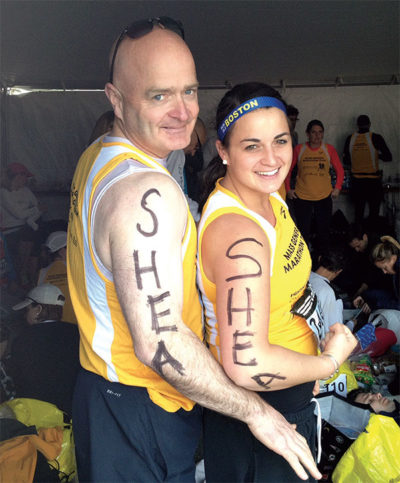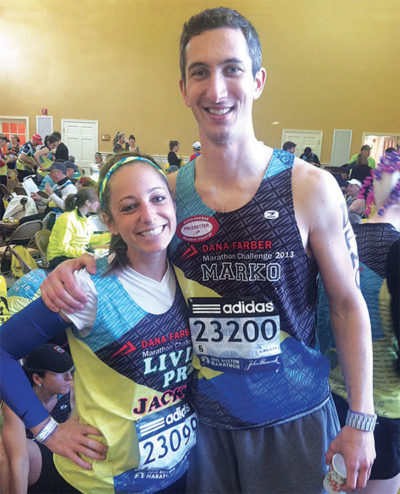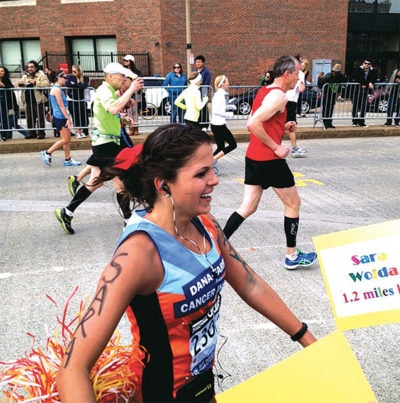The third Monday in April may be Patriot’s Day in Massachusetts, but to many runners and fans the world over, it’s the day of the oldest annual marathon. Recent graduate Elizabeth Shea ’13 sums it up. “For me, it’s Marathon Monday,” she says. “You have to be there to understand the whole of it.”

Elizabeth Shea ’13 and dad, Michael
The 25,000-plus athletes run 26.2 miles for many reasons—to compete, to have fun, to fundraise, to honor a loved one. But this year, on April 15, the events that unfolded were different and difficult to comprehend. The weather was close to perfect, and everything went well until 2:50 that afternoon when the first of two bombs exploded near the finish line. This was the first marathon for Shea, who ran along with her father, Michael, as a member of the Mass General Marathon Team. When she was 10, she had been treated for histiocytosis in the hospital’s pediatric hematology/oncology ward. Shea’s fundraising efforts for pediatric cancer research were successful, but the race was cut short at mile 25.5 for her and her dad. About 3,000 runners were in their immediate area, and news started to leak from those with cell phones. “It was scary, because no one knew if there were more bombs,” Shea remembers. “I thought about people who live in fear like that all the time. I may never understand that, but I experienced it for one and a half hours.”

Jason Jacobs, MBA’05
The race always has held a special place in the heart of veteran runner Jason Jacobs, MBA’05. As founder and CEO of RunKeeper, he ran one year dressed as a smartphone to promote his business, which offers a personal training app. This year Jacobs could see the finish line when he heard the first explosion. “When the second bomb went off, I saw the fireball,” he says. Worried that there might be more, he made his way to the grandstands to look for his wife and their 1-year-old child, who had been there to watch him finish. Frantic moments followed until he heard they were safe.
Jacky Mozzicato ’10 was on her third Boston Marathon as a member of the Dana-Farber Marathon Challenge team. Mozzicato, who exceeded her goal of raising $10,000 to celebrate her 10th year of being cancer-free, runs for the hospital that treated her. Toward the end of the race, Babson friend Joscelyn Chang ’09 hopped in so they could finish together, but their immediate cohort of runners was stopped at mile 24. “There was mass confusion,” says Mozzicato. “I asked a police officer what happened, but he didn’t know. The uncertainty made me feel sick.”

Jacky Mozzicato ’10 and Mark Donnellan ’09
Fellow Dana-Farber team member and a friend of Mozzicato from their Babson days, Mark Donnellan ’09 finished his first marathon in 3:59:27, which brought him in about five minutes before the explosions. He was being treated for dehydration in the medical tent when the bombs exploded. Donnellan was impressed with the medical team, which had not trained for such a large-scale disaster. “The tent quickly became a triage area,” he says, “and the staff remained focused and courageous in spite of the chaos.”
Sara Wojda ’14, another Dana-Farber team member and first-time marathon runner, crossed the finish line in 4:01:36, just one minute before the first explosion. “The noise of the second explosion created panic,” she says. “I cut down a side street to get out of the area, but my legs were so bad I could barely walk.” Wojda knew she needed water, so she returned to the water station near the finish line. The area, which should have been full of volunteers and exhausted runners, was completely deserted.

Sara Wojda ’14
After Wojda connected with her parents, who had seen her run by earlier, the trio walked to their Boston home. As she watched the news, the day felt surreal. “What if my run had taken a minute longer?” she says. “I could have been right there.”
But Wojda won’t let the tragedy cloud her vision of the race, a sentiment shared with the other Babson runners. She’s adamant about running again. “No way that I wouldn’t,” she says. On May 1, she spoke at a memorial ceremony for the victims held in the Glavin Family Chapel. Toward the end of her talk she said, “It’s not about what we haven’t done, what’s in the past, but it’s about what we can do.”
Mozzicato agrees. “I run for a bigger cause than just a marathon. I hope to run for Dana-Farber again. Next year may be even more passionate.”—Sharman Andersen
